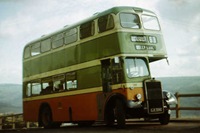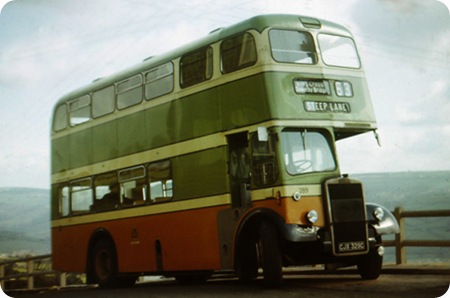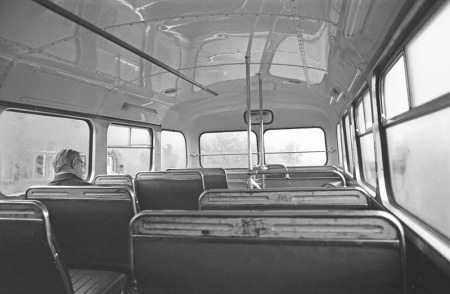Halifax Corporation – Leyland Titan PD2/37 – CJX 329C – 289
Halifax Corporation Transport and Joint Omnibus Committee
1965
Leyland Titan PD2/37
Weymann H36/28F
Halifax buses with fleet numbers below 200 were owned by Halifax corporation, fleet numbers above 200 were owned by the Joint Omnibus Committee.
Photo taken 100 yards from where I used to live. Travelled miles on these Titans.
11/03/11 – 16:18
Nice shot made even better with the Yorkshire hills as a back drop.
Roger Broughton
11/03/11 – 18:58
Steep Lane terminus was perched on the apex of a hill with the reverse manoeuvre carried out by pulling up another hill to the left. There were magnificent views over the Calder Valley from the terminus. If you go there today you may well see preserved buses outside the premises of Yorkshire Heritage Bus Company down below adjacent to the railway line at Luddendenfoot. An unusual feature of Halifax buses pre Fleetline was that the double stainless top rails on the saloon seats had a timber infill with two long finger grips on each side. It’s not something I have come across anywhere else. One (or more?) small brackets were part of the stainless rails which located and secured the timber. Halifax used a rather pleasant ‘Autumn Leaves’ moquette for the lower saloon seating material. The short PD2/37 model was ideal for some of the narrow roads and sharp corners in the Calder and Ryburn Valleys.
Ian Wild
29/05/11 – 07:05
These vehicles did not have the wooden seat infill I think they were the last Weymann bodies as this factory went on strike and closed, some 10 chassis being diverted to Roe. A change away from the brown for double deck specification and removal of leather trim reduced the price and I think they had moquette downstairs and green plastic seats upstairs, I too travelled to school on these when new, they were much nicer than the 241-248 batch
Christopher
22/09/11 – 14:05
Regarding the wooden infill between the double top rails on the seats, I may be wrong here but I seem to recall seeing the same thing on the Bury Corporation PD3/6’s (with GEN registrations). If this was the case it would perhaps not be surprising since they were the last buses ordered by Richard LeFevre whilst GM at Bury, before he moved to Halifax and ordered similar, but forward entrance, PD3’s there. There is a Bury PD3 preserved, maybe someone involved with it could confirm or otherwise.
John Stringer
04/02/12 – 05:27
I seem to recall the earlier Bury Corporation Weymann bodied PD2’s also had the wooden seat infill which supports the theory that it was a LeFevre feature. These PD2’s also had the same destination display which Mr LeFevre took to Halifax. The Bury PD3/6’s had the Nottingham style ‘T’ shape destination display which infers they were actually delivered after Frank Thorpe had moved to Bury from Nottingham.
Philip Halstead
05/02/12 – 06:48
I said "I may be wrong here" – and I was! I met up with the preserved ex-Bury PD3 at the Nocturnal Heart of the Pennines Rally in Halifax last October, and it did not have the wooden seat infills, but I’m still pretty sure I did once see them on some Bury bus or other whilst on a bus club visit there. Do we not concern ourselves with the most obscure things ?
John Stringer
05/02/12 – 16:20
This last batch of Weymann bodied PD2/37 buses for Halifax was delayed by the strike at the Addlestone works. In January 1966, a contingent of staff from HPTD, including Geoff Hilditch himself, set off in Leopard 269 and collected the final few (nine, if I remember correctly) of this order, returning in convoy to Halifax. CJX 329C was one of these.
Roger Cox
05/02/12 – 16:29
This pic. captures very well how smart the Halifax livery could be and even enhance the looks of the Orion style body. If neglected and faded though this livery could look quite shabby.
Eric
06/02/12 – 07:37
It was the orange that faded badly in service, and matching the colour on replacement panels was virtually impossible. It seems that, on 8 August 1956, when Roderick MacKenzie was GM of Halifax, Daimler CVG6 MCCW H33/26R No 285 appeared wearing a reversed livery which had the orange at the top and the green on the lower panels. The negative reaction was so pronounced that the bus was quickly repainted, but the effect surely cannot have been that bad, being rather similar, I would think, to the old, attractive Chatham and District colour scheme. I suspect that good old Yorkshire traditionalism played a part in the antipathy towards the revised colour layout. I am a little surprised that GGH didn’t try this idea again. The maintenance savings would have made it worthwhile.
Roger Cox
06/02/12 – 07:38
Hope I don’t digress here. Whilst I don’t recall the Bury PD3/6’s having wooden infills I most certainly do recall that all the handrails on these buses were light green. Over time this coating wore off to expose the normal silvery metal. This was particularly so where the handrails were highly used by the doors etc. I agree that these buses were a Frank Thorpe style, not only Nottingham and Bury but Newport too. Similar style buses for all three undertakings had two track route number displays both with a small white rectangle to line up and give tidy displays. When viewed from outside the rectangle on the ‘tens’ display was on the right and that on the ‘units’ display was on the left – thus were both between the two displayed numbers resembling a decimal point of sorts so much so that a school chum of mine always referred to service 19 buses as ‘one point nine’
David Slater
06/02/12 – 13:37
Halifax buses generally looked magnificent when newly repainted, but as Eric says they could fade really badly.
By the time I undertook my PSV training in the Summer of 1973 the ex-East Yorkshire ‘Yellow Peril’ full-fronted PD2 Training Bus (403, MKH 81)) had been sold, and there was temporarily no ‘proper’ training vehicle. Instead two PD2 services buses were mostly used, both having expired CoF’s, and which were awaiting overhaul and recertification. These were 67 (DCP 67D) and 221 (MCP 221). Other spare PD2’s were used as well if they were available for a couple of hours or so. The first bus I ever drove was 67. New in 1966 it had reached the end of its initial 7-year CoF, had never been repainted during that time, and now looked really thoroughly down at heel and disgraceful.
Before Skircoat Garage was remodelled in the early 1980’s, there were two old bus side panels attached to the top of one of the rear outside walls just below roof level. They were painted in bands of different shades of green and orange, apparently as a long term trial of various different paint manufacturers’ products to assess their different weathering characteristics. How long they had been up there I never found out.
During the early days of WYPTE, those buses still in the old HPT livery mostly looked absolutely awful – not only very faded paintwork, and in umpteen different shades, but often with scrapes and dents that would never have been tolerated in HPT days. Some even had new panels still in unpainted aluminium, or in a reddish-brown primer, and were an absolute embarrassment to be seen driving, to be honest.
When I was a young child back in the late ‘fifties though, I can remember that the livery used to fade even worse, turning into almost matt pastel shades – the orange becoming almost pale yellow, the green a wishy washy dirty pale shade, and the cream more like off-white. This was probably due to the paint technology of the period and heavy industrial pollution, rather than neglect. Some of the worst were the Joint Committee’s ACP-registered Regent III’s, which probably never received the remedial strengthening work that some of the others had, and which were the first to be sold off in 1958/59.
I recall waking one morning in 1958 to find several of these and other types lined up along the road in front of our house, all with their coats of arms and fleet numbers painted out. Apparently they had been sold to a dealer in London (this would be A.M.C.C) and their drivers were partaking of a hearty breakfast in the nearby transport cafe before setting off on the long journey south. Eventually I watched them all fire up and depart in convoy, and felt really sad to see this shabby, faded and dejected collection vanish round the corner and out of sight.
John Stringer
07/03/12 – 08:43
It is correct to say that Bury had wooden fillets on some batches of its fleet this was a Richard LeFevre design which came about after a female passenger broke her wrist when she fell forward whilst trying to steady herself against the seat top after the bus pulled up sharp. The idea transferred to Halifax when Mr LeFevre became GM along with the Bury destination box too!
Richard McAllister
08/03/12 – 07:05
It’s worth noting that the current accessibility regulations for tramcars (and possibly other modes as well) recognise this issue and prohibit small apertures such as that between the top handrail and the seat frame, for this very reason. Bury and Halifax were clearly quite advanced!
David Beilby
 Vehicle reminder shot for this posting
Vehicle reminder shot for this posting
04/04/12 – 16:29
I thought I had a picture somewhere showing the wooden infills between the top seat rails. Here is what was Halifax Corporation 73, by this time WYPTE 3073, near Mount Tabor on 17th January 1976. Note this batch came after the JOC ones such as 289 and both Weymann-bodied batches DID have these wooden fillers, I’ve checked with my photographs. However, the Roe-bodied ones did not.
David Beilby
05/04/12 – 18:21
Here is a link to another photo of the interior of a Halifax Leyland showing the wooden seat infills. //www.flickr.com/
On this site there are some really fascinating and atmospheric photo’s of Halifax and WYPTE Calderdale buses taken in service by former driver John Thompson in the 1970’s.
John Stringer
20/07/15 – 06:54
Bit late I know but the wooden I fills in the seat back rails were used on Burys Weymann PD2s and the two AECs, numbered 176-186. The earlier Weymann PD2s in the 151-175 number series may also have had them, but they were pretty much on the way out by the time I was old enough to identify the different types so I can’t say for certain.
David Pomfret
Quick links to the - Comments Page - Contact Page - Home Page
Comments - Please note: The comments facility is not currently available. Please see the home page for updates.
Please Note if you want to send a photograph with your comment please use the Contact Page by clicking here or send as an attachment via email.


